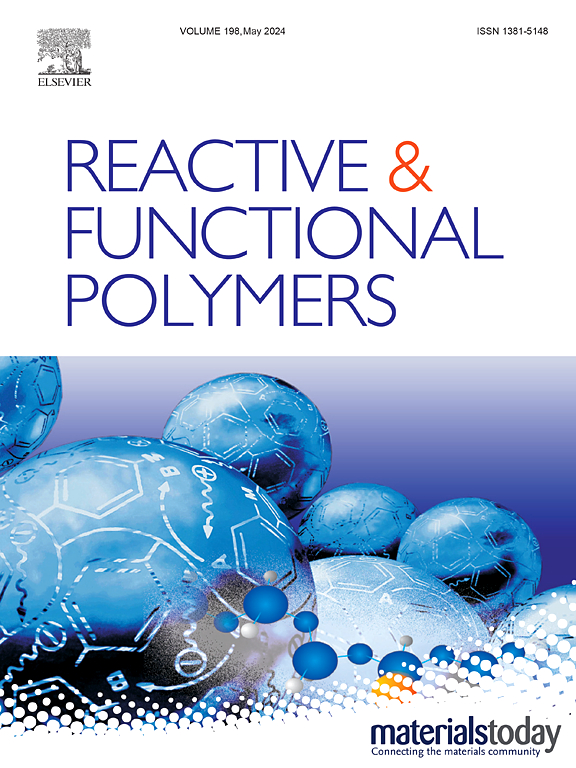Synthesis of double-ended hydroxyl-terminated poly(cyclohexyl ethylene) via catalytic hydrogenation of double-ended hydroxyl terminated polystyrene
IF 5.1
3区 工程技术
Q1 CHEMISTRY, APPLIED
引用次数: 0
Abstract
This study synthesized a novel double-ended hydroxyl-terminated poly(cyclohexyl ethylene) (HO-PCHE-OH), and investigated the individual and interactive effects of reaction temperature, time, and stirring speed on the synthesis of double-ended hydroxyl terminated polystyrene (HO-PS-OH) via the anionic polymerization of styrene, employing sodium-naphthalene as the initiator. A central composite design (CCD) combined with response surface methodology (RSM) was utilized for experimental design, process modelling, and optimization. The optimal reaction conditions were determined to be a temperature of 17.9 °C, a reaction time of 46.7 min, and a stirring speed of 189.1 rpm, yielding a styrene conversion of 91.1 %. The synthesized HO-PS-OH was subsequently subjected to catalytic hydrogenation to enhance its properties, achieving complete hydrogenation within 4 h at 170 °C. The successful transformation of HO-PS-OH into double-ended hydroxyl-terminated poly(cyclohexyl ethylene) (HO-PCHE-OH) was confirmed through nuclear magnetic resonance (1H NMR and 13C NMR) spectroscopy and Fourier transform infrared (FTIR) analysis. Therefore, the complete saturation of the 6-member carbon ring in HO-PCHE-OH was chemically and photochemically inert. Furthermore, the thermogravimetric analysis revealed that HO-PS-OH exhibited thermal resistance, with a degradation onset temperature of 420.85 °C, while HO-PCHE-OH demonstrated a higher degradation onset temperature of 431.55 °C.

通过催化氢化双端羟基封端聚苯乙烯合成双端羟基封端聚环己基乙烯
本研究合成了一种新型的双端端羟基聚(环己基乙烯)(HO-PCHE-OH),并以萘钠为引发剂,考察了反应温度、时间和搅拌速度对苯乙烯阴离子聚合合成双端端羟基聚苯乙烯(HO-PS-OH)的单独影响和相互作用。采用中心复合设计(CCD)和响应面法(RSM)进行实验设计、工艺建模和优化。最佳反应条件为反应温度17.9 °C,反应时间46.7 min,搅拌速度189.1 rpm,苯乙烯转化率为91.1 %。合成的HO-PS-OH随后进行催化加氢以提高其性能,在170 °C下,在4 h内实现完全加氢。通过核磁共振(1H NMR和13C NMR)波谱和傅里叶变换红外(FTIR)分析证实了HO-PS-OH成功转化为双端羟基端聚环己基乙烯(HO-PCHE-OH)。因此,HO-PCHE-OH中6元碳环的完全饱和是化学和光化学惰性的。此外,热重分析表明,HO-PS-OH具有热阻性,降解起始温度为420.85 °C,而HO-PCHE-OH的降解起始温度更高,为431.55 °C。
本文章由计算机程序翻译,如有差异,请以英文原文为准。
求助全文
约1分钟内获得全文
求助全文
来源期刊

Reactive & Functional Polymers
工程技术-高分子科学
CiteScore
8.90
自引率
5.90%
发文量
259
审稿时长
27 days
期刊介绍:
Reactive & Functional Polymers provides a forum to disseminate original ideas, concepts and developments in the science and technology of polymers with functional groups, which impart specific chemical reactivity or physical, chemical, structural, biological, and pharmacological functionality. The scope covers organic polymers, acting for instance as reagents, catalysts, templates, ion-exchangers, selective sorbents, chelating or antimicrobial agents, drug carriers, sensors, membranes, and hydrogels. This also includes reactive cross-linkable prepolymers and high-performance thermosetting polymers, natural or degradable polymers, conducting polymers, and porous polymers.
Original research articles must contain thorough molecular and material characterization data on synthesis of the above polymers in combination with their applications. Applications include but are not limited to catalysis, water or effluent treatment, separations and recovery, electronics and information storage, energy conversion, encapsulation, or adhesion.
 求助内容:
求助内容: 应助结果提醒方式:
应助结果提醒方式:


